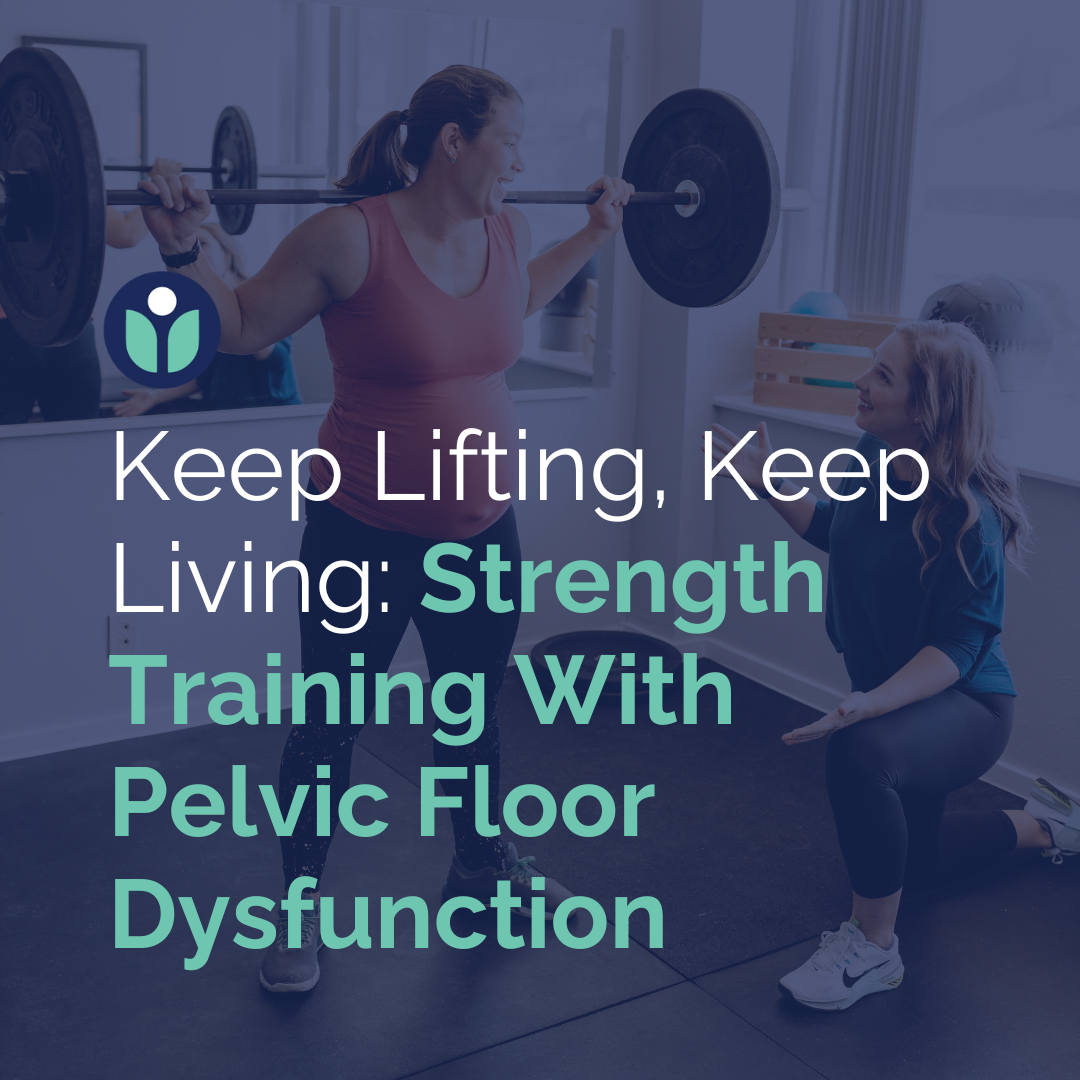Keep Lifting, Keep Living: Strength Training with Pelvic Floor Dysfunction
Keep Lifting, Keep Living: Strength Training with Pelvic Floor Dysfunction
There’s a common misconception that if you have pelvic floor dysfunction, you need to stop lifting weights. Many people come into pelvic floor therapy feeling unsure about how strength training affects their symptoms—or if they should be lifting at all. But here’s the truth: you don’t have to give up strength training! In fact, the right approach can be a powerful tool for your rehab and overall pelvic health.
In this blog, we’ll break down how to tell if lifting is contributing to your pelvic floor symptoms and how to modify your training to support your recovery.
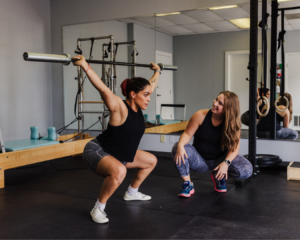
Strength starts with form! Your pelvic floor plays a key role in lifting safely and effectively. Working on proper technique can prevent injury and build confidence!
Understanding Pelvic Floor Dysfunction
Pelvic floor dysfunction means that the muscles of your pelvic floor aren’t working the way they should. Since these muscles play a key role in bladder and bowel function, sexual health, and core stability, dysfunction can show up in a variety of ways, including:
- Bladder leaks
- Urinary urgency
- Constipation
- Pain with sex
- Heaviness or pressure (pelvic organ prolapse)
- Tailbone pain
- Discomfort, tightness, or pain during or after exercise
For those who strength train, these symptoms can be frustrating—leaking with jumps or heavy lifts, pain that lingers after workouts, or tightness that doesn’t seem to go away. This can make it tempting to avoid specific exercises altogether, but the good news is that there are ways to keep lifting while protecting your pelvic floor.
How Strength Training Can Benefit Pelvic Floor Health
Your pelvic floor does a lot more than you might realize—it helps with bladder and bowel control, supports intimacy, and plays a key role in stability during movement. Whether you’re walking, lifting groceries, or even rearranging furniture, your pelvic floor is working behind the scenes to support you. It’s also a crucial part of your core, working alongside your abdominal, back, and hip muscles to keep everything moving efficiently.
Key Muscles That Support the Pelvic Floor

Movement matters! Addressing mobility, mechanics, and stability helps you move better and feel stronger. Small adjustments make a big impact!
While the pelvic floor is important, it doesn’t work alone! Other muscle groups provide crucial support, including:
- Glutes: Strong glutes help with bladder control, posture, and overall pelvic stability. This includes the muscles that give shape to your butt (gluteus maximus, medius, and minimus) as well as deeper hip rotators like the piriformis and obturator muscles.
- Feet: Healthy, well-functioning feet improve movement control during lifts. When feet and hips aren’t strong or mobile enough, your pelvic floor may overcompensate, leading to tightness or dysfunction.
If you’re experiencing any of the following, it could be a sign that your glutes, feet, or other supporting muscles need attention:
✔️ Snapping hip
✔️ Sciatica
✔️ Low back pain
✔️ Flat feet
✔️ Plantar fasciitis
✔️ Knee pain
Since these issues aren’t always easy to recognize on your own, a pelvic floor therapist can assess your movement and determine if weakness or dysfunction in these areas is contributing to your symptoms.
Why Strength Training Matters
Lifting weights isn’t just about building muscle—it also improves pelvic floor strength, stability, and coordination. A strong, functional pelvic floor helps with:
- Bladder control
- Pain-free intimacy
- Healthy pregnancy and postpartum recovery
- Walking, lifting, and daily movement without discomfort or injury
And while you’re not directly lifting with your pelvic floor, these muscles still activate to support your body—especially during big compound movements like squats, deadlifts, and overhead presses. That’s why strength training can be such an effective tool for pelvic floor health when done correctly!
De-Bunking The Myth That Heavy Lifting is “Bad”
One of the biggest misconceptions about pelvic floor dysfunction is that you need to stop lifting weights altogether. While there are times when taking a temporary step back may be helpful, avoiding strength training completely isn’t always necessary—or even healthy.
If you’re experiencing pain or leaking while lifting, the solution isn’t always to stop. Often, simple adjustments—like tweaking your technique, posture, grip, or breathing strategy—can make a huge difference. A pelvic floor PT can help you modify your approach so you can keep doing what you love without worsening symptoms.
What About Strength Training During Pregnancy?
If you were already lifting before pregnancy and have been cleared by your provider, strength training can still be a safe and beneficial part of your routine! However, some adjustments are necessary to keep things safe:
✅ Avoid pushing for max lifts or heavy loads without a spotter
✅ Make modifications as needed to avoid overexertion
✅ Work with a qualified trainer or PT if you’re new to lifting
Building strength during pregnancy can help prevent pain, reduce complications, and support your pelvic floor for both birth and postpartum recovery. That’s why we recommend every pregnant person get a pelvic floor PT evaluation to ensure they’re moving safely and effectively throughout pregnancy.
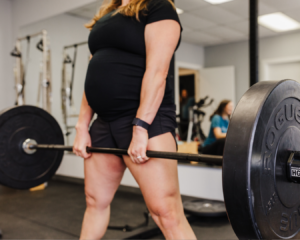
Pregnancy doesn’t mean stopping—it means adjusting! Strength training with expert guidance helps keep you moving safely while supporting your changing body.
Safe Lifting Techniques
Strength training is an amazing tool for building a resilient body, but how you lift matters—especially when it comes to your pelvic floor. Using proper form and breath techniques can help protect against symptoms like leaking, pressure, or discomfort during workouts.
Key Tips for Safe Lifting
To keep your pelvic floor happy and strong during lifts, try these general guidelines:
✔️ Exhale during exertion – Breathe out during the hardest part of the lift to manage pressure effectively. If needed, you can pair this with a brief, controlled breath hold for extra support.
✔️ Avoid holding your breath – Breath-holding (aka the Valsalva maneuver) can put excess pressure on the pelvic floor, especially if you’re already dealing with dysfunction.
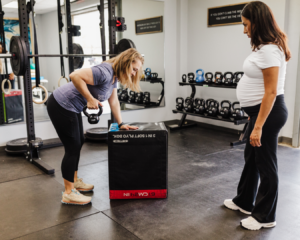
“Guidance matters. Proper form and technique can make all the difference in your recovery.”
✔️ Train with unilateral (single-limb) movements – This helps address strength imbalances and improve overall stability. Examples include:
- Lunges
- Stagger stance squats & deadlifts
- Single-arm carries
- Cable hip abductions
- Kettlebell military presses
✔️ Focus on core stability – Instead of excessive crunches, build core strength with static positions like:
- Side planks
- Cable rows
- Dumbbell or kettlebell carries
Breath & Posture Matter Too!
The way you breathe and position your body during a lift directly affects your pelvic floor. Good breathing technique helps the pelvic floor contract and lengthen properly to match the demands of your workout, reducing unnecessary strain. If you’re unsure whether your breathing or posture is working for you, a pelvic floor PT can assess and adjust your technique.
FAQs
Q: Can I still lift heavy weights if I have pelvic floor dysfunction?
Maybe! It depends on how your body responds. If you notice symptoms like leaking, pressure, or pain during or after workouts, it’s a sign that your pelvic floor might not be managing the load well. Instead of stopping entirely, try modifying first:
✔️ Lower the weight to see if symptoms improve.
✔️ Go bodyweight-only if needed.
✔️ Reduce the range of motion to maintain better control.
If symptoms persist, it might be best to temporarily pause heavy lifting and work with a pelvic floor physical therapist (PT). A PT can assess your movement and recommend adjustments so that strength training supports your recovery instead of making symptoms worse.
Q: What are the best exercises for strengthening my pelvic floor while weightlifting?
The truth? Almost all strength exercises engage your pelvic floor—it’s constantly working to stabilize your body! But some movements are especially great for pelvic floor activation, including:
🏋️ Squats & deadlifts – Full-body strength builders that engage the core and pelvic floor.
🚶♀️ Farmer’s walks – Promote deep core and pelvic stability.
💪 Rows & Pallof Presses – Encourage core control and anti-rotation strength.
🦵 Kickstand Romanian deadlifts – Strengthen one side at a time for better balance.
🍑 Hip thrusts – Target the glutes and surrounding pelvic stabilizers.
These exercises don’t just strengthen the pelvic floor—they also build overall core and lower body strength, which supports pelvic health in everyday life.
Q: How do I know if I’m doing a pelvic floor-safe squat or deadlift?
Here’s how you can tell if your squat or deadlift is working for you instead of against you:
🚨 Symptoms to watch for:
🔹 Leaking urine or feeling heaviness/pressure in the pelvis during or after lifting.
🔹 Pain in the low back, tailbone, pubic bone, or genital area.
These could be signs that your pelvic floor is under too much strain, either from excess pressure or poor coordination with the surrounding muscles. If symptoms don’t improve with modifications (like breath control, posture adjustments, or lighter loads), it’s worth getting checked out by a pelvic floor PT.
Seeking Help: When & How to See a Pelvic Floor PT
A pelvic floor PT can assess:
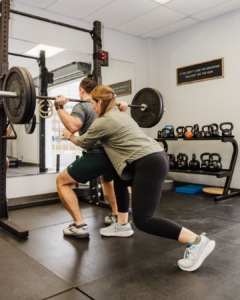
Squat smarter, not harder! Proper hinging and core activation make all the difference in lifting efficiency and injury prevention.
- Pelvic floor strength, endurance, and coordination
- Your lifting technique & movement patterns
- Modifications to keep you training safely
What Does A Pelvic Floor Treatment Plan Look Like?
- Initial assessment: Typically, 1-2 visits to evaluate symptoms and movement.
- Treatment plan: Usually 8-12 weeks, though this varies based on individual needs.
If symptoms aren’t improving after a few weeks, seeking help sooner rather than later can prevent further injury or setbacks. Chronic issues often take longer to rehab, so don’t wait too long to get checked out.
How to Find the Right PT for Strength Training
You can see a pelvic floor PT with or without a doctor’s referral (this is called direct access, and all 50 states allow some form of it!). When booking, ask:
- Do you have experience working with strength athletes?
- What modifications can I make to my workouts instead of stopping completely?
- How do I know when to stop an exercise vs. modify it?
These questions help ensure you’re paired with a provider who understands both pelvic health and lifting so you can keep training confidently and safely.
Wrapping Up
Pelvic floor dysfunction is incredibly common in all genders—and the good news? It’s treatable! Evidence-based, expert care is available, and in most cases, you won’t have to give up the exercise you love.
A pelvic floor PT can help you understand how your strength training impacts your pelvic floor and guide you through modifications that support both your performance and rehab goals. Strength training isn’t just something to work around—it’s a powerful tool for recovery and long-term pelvic health.
With the right approach, you can keep lifting, keep moving, and keep feeling strong.
Contact Us
Have questions or want to learn more about how physical therapy can help you level up your lifting game? Reach out—UpLift is here to guide you through your pelvic floor journey!
UpLift Physical Therapy Website
Phone: 210-468-7398
Email Us
Follow us on social media: Instagram @upliftptp

